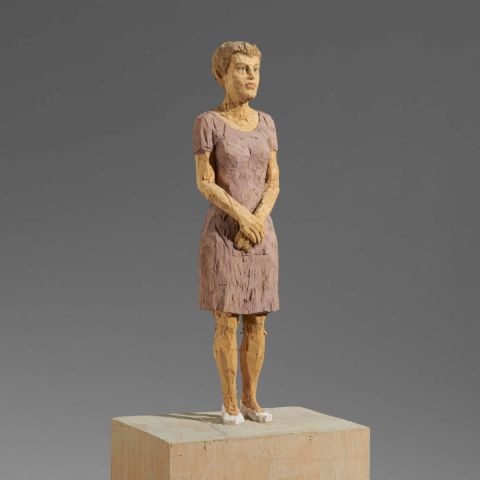
Lot 55 | Andy Warhol | Untitled (Floral Still Life)
1928 Pittsburgh, PA/USA - 1987 New York
Title: Untitled (Floral Still Life).
Date: Around 1956.
Technique: India ink, watercolour, gold leaf and silver paper on paper.
Measurement: 42.5 x 34.9cm.
Notation: Signed lower right: Andy Warhol. Verso lower left with the stamp of the Andy Warhol Art Authentication Board and the number A121.089.
Frame/Pedestal: Craftman's frame.
This work is accompanied by a certificate from the Andy Warhol Art Authentication Board, New York, dated 10th October 2008.
Provenance:
- Marilyn Kaytor Collection, New York
- Doyle Auctions, New York, Auction 20th May 2008, lot 2197
- Galerie Michael Haas, Berlin (adhesive label)
- Private Collection, North Rhine-Westphalia (acquired from the previous owner in 2009)
- An early, full-page work demonstrating Warhol's illustrative mastery
- Gold as a key element in Warhol's fascination with the fetishization of objects and icons
- This work foreshadows his development from graphic designer to fine artist
The Andy Warhol brand
As the most important representative of Pop Art, Andy Warhol was also a key figure in the New York creative scene that formed around his Factory, founded in 1962. This legendary place, which Warhol used as a studio for his art production, also attracted dazzling personalities as a film studio and party location. Just as he gathered flamboyant personalities around him to promote himself and became a cult figure, Warhol greedily absorbed the products of popular culture: commercial advertisements and photos from flyers, cinema magazines, and magazines such as Life and Time Magazine. Warhol responded to the collective recognition value of these images with his increasingly successful screen printing reproduction process. He repeatedly reproduced Marilyn Monroe, Coca-Cola, and Mickey Mouse, ultimately creating images that have become icons of 20th-century art using the insignia of American culture. In doing so, he subjected his models to a deconstructive form of citation, whereby they were decontextualized and emptied of meaning, reduced to their pure, dazzling surface. By adopting these deceptive effects, which originate from the visual language of advertising, Warhol appropriated the aesthetics of seduction: his works exude the aura of a brand, the Warhol brand, and are traded as coveted status symbols.
As highly attractive trophies, they expose the idealization of celebrities and luxury items, the shallow clichés of consumer culture. With his postmodern “anything goes” aesthetic, Warhol undermines the categories of high and low. Furthermore, he seeks proximity to commerce and declares venality to be a value. The Factory's high-speed serial production turns the artwork into a commodity and Warhol into a successful businessman. Everything is for sale, everything can be transformed by Warhol and turned into gold.
Graphic appeal
After studying commercial art at the Carnegie Institute of Technology in Pittsburgh, Warhol moved to New York. In the city of art and stronghold of advertising, he gained widespread recognition as an advertising and industrial graphic designer, earning his living with illustrations for fashion, glossy, and lifestyle magazines such as Vogue and Harper's Bazaar. In 1952, he illustrated short stories by Truman Capote, and in 1956, he was represented with a drawing in the exhibition “Recent Drawings USA” at the Museum of Modern Art. During this time, he devoted himself to decorative everyday objects, putting pleasing motifs of angels, butterflies, shoes, and cats on paper with playful, light, loose pencil strokes. He often traced them with ink and then transferred them wet onto a new sheet of paper. This early method of reproduction anticipates his later silkscreen prints and characterizes Warhol's systematic and subversive undermining of the relationship between original and copy.
Shining gold modesty
This early work dates from this style-defining period—in 1956, Warhol reached the peak of his success as a draftsman and graphic artist. His outline-emphasized and at the same time two-dimensional rendering of a bouquet of flowers displays the characteristics with which Warhol stylized his subjects in his later silkscreen prints. However, what is remarkable here is the careful craftsmanship and attention to detail with which Warhol captures the internal forms with the irregular lines in ink that were characteristic of his work at the time. Lush, fluttering, finely petaled flowers—they could be tulips or poppies—in stronger and paler shades of orange are generously distributed throughout the picture space. Their stems branch out from an antique metal jug with a hinged lid tilted to one side. Warhol simulates the dull, gray quality of tin or lead with streaky watercolor paint, into which he inserts specks of silver paper. The petals unfolding in all directions are surrounded by a precious, shiny background of gold leaf. Warhol applies traditional finishing techniques from Russian icon painting and medieval panel paintings: he is familiar with the material symbolism of the gold background against which the holy figures are gathered and adopts its sacred meaning. The exquisite surface emphasizes the grandeur of the depiction—Warhol introduces a grandeur and exclusivity that stands out from the everyday nature and modesty of the floral still life.
Bettina Haiss
Print this lot | Recommend lot |
Conditions of this Lot
32% buyer’s premium on the hammer price
Estimated shipping costs for this lot:
Arrangement after the auction.
Andy Warhol USA Pop Art Photographs Post-War Art Post War 1950s Craftman's frame Flowers Drawing India ink and watercolour Still Life
More lots which could be of your interest
- Estimate: 50.000 - 70.000 €
03.12.2025 - ca.18:40Modern | Post War | Contemporary | Galerie Thomas | The Jagdfeld Collection | Auction 03.12.2025 - Estimate: 300.000 - 500.000 €
03.12.2025 - ca.18:42Modern | Post War | Contemporary | Galerie Thomas | The Jagdfeld Collection | Auction 03.12.2025 - Estimate: 30.000 - 50.000 €
04.12.2025 - ca.17:54Modern | Post War | Contemporary | Galerie Thomas | The Jagdfeld Collection | Auction 03.12.2025 - Estimate: 80.000 - 120.000 €
03.12.2025 - ca.18:39Modern | Post War | Contemporary | Galerie Thomas | The Jagdfeld Collection | Auction 03.12.2025









